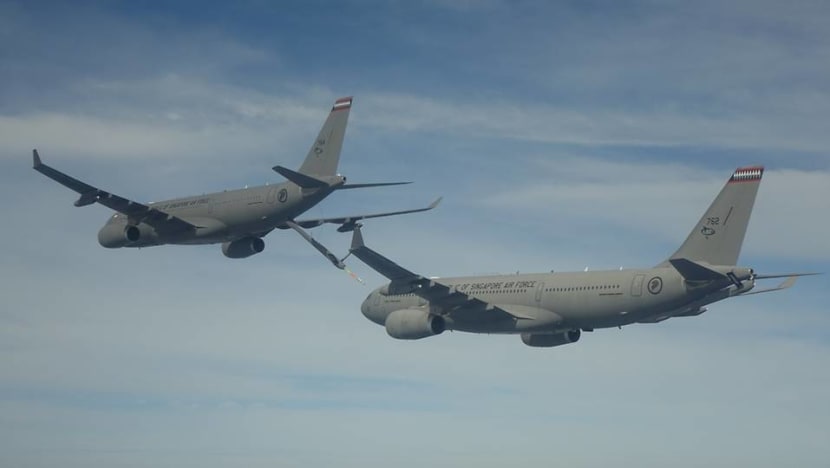Commentary: Singapore’s A330 tanker-transport plane offer can help in Afghanistan evacuation where every bit counts
It may be a small contribution to the multinational airlift effort evacuating fleeing Afghans but at this late hour, every help is needed, says defence writer Mike Yeo.

An RSAF Airbus A330 multi-role tanker transport (MRTT) tanking with another MRTT. (Photo: MINDEF)
SINGAPORE: If accepted, Prime Minister Lee Hsien Loong’s offer of a Republic of Singapore Air Force (RSAF) Multi-Role Tanker Transport (MRTT) to US vice-president Kamala Harris during her visit to Singapore will be a small but significant contribution to the ongoing multinational airlift effort evacuating Afghans fleeing the Taliban takeover of embattled Afghanistan.
The aircraft, based on the Airbus A330 commercial airliner, can perform several roles required of the airlift, and its flexibility means it can pivot from one role to another effortlessly.
This will be useful in situations where the MRTT will need to refuel aircraft in mid-air while carrying a full load of passengers and cargo.
The RSAF operates six MRTTs with its 112 Squadron out of Changi East airbase, where they replaced four older Boeing KC-135R tankers built in the early 1960s. These had served with the US Air Force before they were bought and refurbished by Singapore in the late 1990s.
Each MRTT can carry 111 tonnes of fuel, 266 passengers and 37 tonnes of cargo all at the same time. This is an increase of 20 per cent in fuel carriage capacity over the KC-135R they replaced in RSAF service.
They also boast a significant increase in cargo and passenger capacity over the smaller KC-135R, which was limited to 37 tonnes in passengers or cargo.
The RSAF 112 Squadron received its first MRTT in 2018 and achieved full operating capability in April this year.
In addition to being able to refuel the RSAF’s F-15 and F-16 fighter jets along with other RSAF MRTTs in mid-air, the RSAF has also conducted refuelling training with aircraft from friendly nations, including MRTTs from the Royal Australian Air Force and Royal Thai Air Force F-16s.
LIKELY MISSIONS IN AFGHANISTAN
It is not clear what missions the RSAF MRTTs will undertake in the airlift to evacuate Afghans, although they can fly several types likely needed, including flights into the Afghan capital Kabul’s airport to directly evacuate Afghans seeking to leave, transporting Afghans who have already left to locations further afield or acting as tankers refuelling other aircraft.
The first will undoubtedly see the most risk, given the chaos at Kabul airport and the Taliban surrounding its vicinity. Flying at low altitude during landing and take-off also exposes the aircraft to the risk of attacks from small arms and light anti-aircraft weapons.
The MRTTs can be fitted with an aircraft protection suite that includes decoys and jammers for detecting and defeating incoming missiles, although it is unclear if the RSAF’s aircraft have such systems.
This mission is currently being undertaken by specialised military transport aircraft such as the US British, Australian, Qatari and United Arab Emirates Boeing C-17 Globemaster III as well as Airbus A400M from France and Germany.
One of the former set a chilling new record for number of passengers carried on a flight when it supposedly flew 823 Afghans, including 183 children, out of Kabul on Aug 15.
These flights from Kabul are currently flying evacuated Afghans to airbases in Kuwait, Qatar and the United Arab Emirates, among other locations.
The evacuees are then processed and flown out to military bases further afield such as Sigonella in Italy to free up room for those being lifted out on further flights.
The MRTT can be used to ferry evacuees on these other flights, joining 18 aircraft from various US airlines (including American Airlines and United Airlines) recalled by the US Department of Defense as part of its Civil Reserve Air Fleet, a programme only used twice in the early 1990s and early 2000s during the Iraq wars.
These aircraft free up US Air Force tanker and transport aircraft previously used for such tasks to perform other missions.
The third potential mission type will see the RSAF MRTT act as a tanker and join the constant stream of US Air Force KC-10 and KC-135 tankers observed shuttling between bases in the Middle East and Afghanistan since the evacuation operation began on open-source flight tracking website Flightradar24.
These planes are likely to be occupied with offloading fuel to transport aircraft such as the US Air Force C-17s flying between Kabul and elsewhere in the Middle East or to the four squadrons of US Navy and Air Force F/A-18 and F-16 fighter jets providing air cover for the evacuation missions, together with AV-8 strike aircraft, AC-130 gunships, B-52 bombers and MQ-9 intelligence and attack drones.
The approximately 40 F-18 Super Hornets are flying from the aircraft carrier USS Ronald Reagan, currently in the Arabian Sea and was tasked with covering the planned US withdrawal from Afghanistan before the situation on the ground dramatically fell apart earlier this month.
Given that fighter jets carry less fuel and are powered by higher-performance engines than transport aircraft, they will need more mid-air refuelling cycles to stay in the air, and an additional tanker will no doubt be useful to have.
The RSAF’s MRTTs are not known to have refuelled Super Hornets before, although RSAF KC-135Rs have previously refuelled US military aircraft at exercises such as Pitch Black in Australia and operations such as the air campaign against the Islamic State over Iraq and Syria.
Their Australian counterparts flying the MRTT have also managed to do so with their own and American Super Hornets during these exercises, with well-established procedures.
The Australians have also shared refuelling performance data for both jets with partner nations via the North Atlantic Treaty Organisation (NATO) Joint Air Power Competence Centre, which Singapore participated in, providing a baseline plan for other operators who might work together.
A HUMAN CATASTROPHE
The air bridge ferrying these evacuees include hundreds of aircraft and personnel. Mos are American, but the involved plans also include those from the United Kingdom, Germany, Qatar, Australia and the United Arab Emirates.
Some 48,000 people have been evacuated from Kabul as of Monday since the airlift began a week ago, according to the US Department of Defence.
These include foreign nationals, Afghans who assisted the international coalition and their dependents, and others who risk being targets of the Taliban’s reprisal attacks.
Given the scale of the task at hand and the resources already in place, the addition of an MRTT from Singapore might seem small. However, with thousands of foreign nationals and Afghans still seeking to leave Kabul and some 5,000 US troops still at the airport providing security, every bit would count.
An estimated total of 15,000 Americans and 50,000 to 60,000 more Afghan allies must be evacuated, according to the Biden administration. This makes the need to move quickly imperative. Once Singapore’s offer is accepted and diplomatic clearances sorted with a host country offering the use of their bases, the RSAF can be at the scene quickly.
There is urgency given that US President Joe Biden has pledged to withdraw all US forces from Afghanistan by the end of August.
It is unclear what the Taliban, which has surrounded the airport and warned of “consequences” if US withdrawal is delayed but thus far avoided a confrontation with American troops, would do when this deadline expires, adding to the urgency of the task to get as many people out of Kabul as possible.
Mike Yeo is the Asia reporter for US-based defence publication Defense News.




















